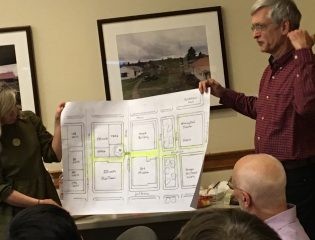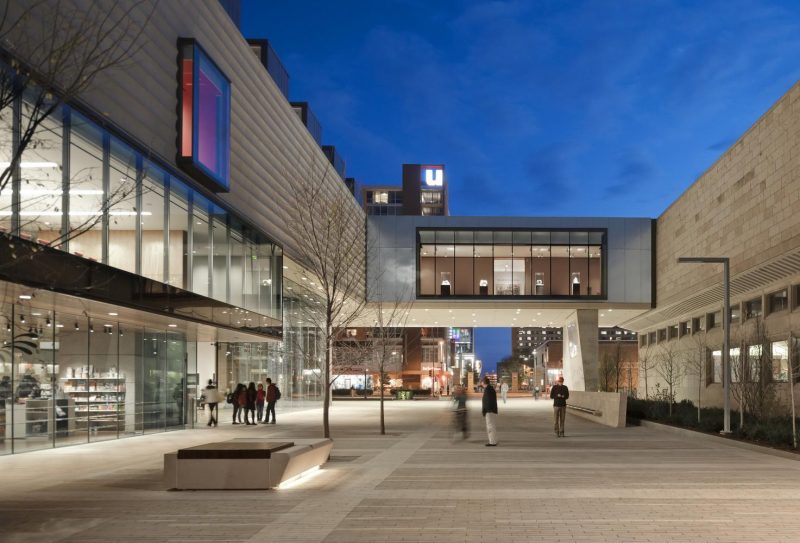
(Photo: J Maus/BikePortland)
Two influential City of Portland advisory committees oppose plans by the Portland Art Museum to create a new structure that would limit public access on a downtown block.
As we reported on March 29th, the Portland Art Museum’s $50 million Rothko Pavilion plans would further restrict public right-of-way between Southwest Park and 10th Avenues. On March 14th, at a joint meeting of the Portland Bicycle Advisory Committee and the Portland Pedestrian Advisory Committee, members overwhelmingly opposed the plans in an informal straw poll. Before taking an official position on the matter, the chair of the bicycle committee invited a representative from the museum to a subsequent meeting.
“PBOT really stresses the need for connectivity. We’re really struggling with this issue.”
— Christine Leon, PBOT Development Permitting and Transit Group Manager
On Tuesday Portland Art Museum Chief Advancement Officer JS May made his case. After introducing himself as a bicycle rider and former board member of The Street Trust (formerly the Bicycle Transportation Alliance) and current board president Cycle Oregon, May told the committee, “I rode through Madison plaza on my way over here tonight. I’m one of the people this is going to inconvenience.” But May added that he’s not going to be around in 125 years and this project is about something larger. “What does the city want in terms of its vision? People can look at this as a pedestrian issue or a bicycling issue or an arts access issue — what we’re trying to do is balance those three things.”
For the museum, the goal is to “Create one of Portland’s grand public spaces.” But the crux of this issue revolves around whether or not the public will have adequate access to that space — and how that space will limit connectivity, a bedrock of good urban planning.
According to the official city ordinance up for adoption at City Council this Thursday (4/20), the Rothko Pavilion would restrict public access through the block for an additional four to eight hours per day. It would also completely prohibit bicycling. The museum currently operates with an easement on that block first granted in 1968. That easement required an eight-foot minimum path for the public 24 hours a day. In 1984 the museum requested — and was granted — permission to close the plaza at night due to security and vandalism concerns. Museum officials now want to build a new structure and limit public access to only museum hours.
The letter jointly signed by the chairs and vice-chairs of both advisory committees, lists the following concerns:
● The amendment diminishes the usefulness and network connectivity for people who walk and bike along SW Madison utilizing the vacation between SW 11th Avenue and SW 10th Avenue adjacent to the YMCA.
● The presence of small, walkable (and publicly-accessible) blocks are critical to a pedestrian-oriented city, especially downtown where the standard block size is 200×200 feet.
● The proposed creation of a superblock, even with the described access, fails to live up to the city’s adopted goals of a walkable city.
● Public access to this block has been incrementally eroded over the years, and the proposal is an unacceptable further limitation of public access.
● The renderings and proposed language regarding the new Rothko Pavilion creates the appearance of a private building entrance blocking a vacated street, which will create the perception that only paying Museum customers will be able to use this connection, and that all other individuals not using the Museum should walk around the building.
● Allowing this exception to the city’s street vacation policy will set precedent and prompt future requests that would further compromise Portland’s renowned pedestrian and bicycle network.
Advertisement
PBOT is feeling pressure from both sides. “PBOT really stresses the need for connectivity,” said the city’s Development Permitting and Transit Group Manager Christine Leon at the Bike Advisory Committee meeting on Tuesday. “We’re really struggling with this issue.”
Bicycle Advisory Committee member Elliot Akwai-Scott shared similarly conflicted feelings: “We all support what the museum is trying to accomplish; but not the way they’re trying to achieve it.”
“We all support what the museum is trying to accomplish; but not the way they’re trying to achieve it.”
— Elliot Akwai-Scott, Bicycle Advisory Committee member
While the museum won’t charge a fee to use the new pavilion or travel through it, there are worries that most people will see a building structure and will assume it’s only for paying museum customers. Other committee members expressed worries that granting this easement would set a dangerous precedent for other central city developers who’d want to limit public access — resulting in less connectivity and eroding Portland’s efforts to encourage biking and walking.
PBOT Project Manager Caitlin Reff said they get many requests to close public access through private property and the city’s current stance is to “maintain connectivity standards at the highest threshold we can deliver.”
The ordinance language released Friday states that the easement must be “unobstructed” and “include clear wayfinding with no visual obstruction.” It’s unclear if the city would allow an enclosed pavilion like the museum has proposed (we’ve asked PBOT for clarification but have not heard back). (UPDATE: The ordinance doesn’t require an open plaza, just that the structure be clear and transparent.)
Rithy Khut, chair of the Bicycle Advisory Committee, wants the museum to find a different solution. “There’s a possiblity that the design team could design a building that the public could pass through, isn’t that correct?” he asked May. “We’ve looked at that,” May replied. “One of the design goals is to make this ground floor a community commons, a place full of art… It’s very hard to also make that be a pass-through that would be open all times of day.”

Noted walking advocate Doug Klotz spoke up in opposition to the museum’s plans. He brought a diagram with current access routes highlighted and told the committee, “If it has doors, it won’t work. It has to be open. I’m not in favor of putting any structure there.”
Khut and other advocates agree with Klotz and think an elevated structure that leaves the ground floor open is the answer. They point the Chazen Museum in Madison Wisconsin, the Hirshhorn Museum in Washington D.C. and the Rijksmuseum in Amsterdam as examples of museum expansions that maintained through access for the public. May shot down the Amsterdam example, citing its $500 million price tag. “It’s a different world,” he said, about a country with more money and more taxes to spend on projects.
But it appears the biking and walking committees aren’t taking no for an answer. Here’s an excerpt from their letter:
“We believe that PAM and their architects have a unique opportunity to meet the policy goal of Policy 9.46 within the proposed Central City Plan for 2035 [which states that projects should, “Differentiate the character of key streets to offer a diversity of urban experiences and connections, reflect the character of unique districts and expand open space and recreation functions in the right-of-way where possible.”]… By maintaining unfettered access throughout the day, no other location in the Central City can provide this experience where the Right-of-Way can be directly intertwined with the cultural and artistic urban experiences. We are confident that the excellent design team at Vinci Hamp Architects can design a Rothko Pavilion that will allow continuous access… we feel confident that Vinci Hamp Architects can design a building that meets both the requirements of continuous access while connecting both museum spaces, ultimately creating a space that meets the goals of the Portland Art Museum, the City of Portland Transportation System Plan, the Central City Plan for 2035, and most importantly, people who walk and bike along SW Madison Avenue.”
Bicycle Advisory Committee member Dan Bower (executive director of Portland Streetcar Inc), agrees. “I think we should push this as a design challenge to the museum… they can solve it.”
The new easement is up for a vote at City Council this Thursday at 2:00 pm.
UPDATE, 4/18 at 8:00 am: The City of Portland Planning and Sustainability Commission has requested a delay in the City Council vote on this issue. The request was made in a letter to Mayor Ted Wheeler and City Council from PSC Chair Katherine Schultz dated April 14th. “The PSC would like to emphasize to City Council that public access across this location is very important,” it reads. “The design of whatever replaces the current open connection is critical for this connection to be successfully replaced. We should not start the design of a replacement with the assumption that reducing the connection from full access to pedestrian-only is acceptable other than as a last resort.” The PSC will host a hearing with public comment opportunity at their meeting on April 25th.
— Jonathan Maus: (503) 706-8804, @jonathan_maus on Twitter and jonathan@bikeportland.org
BikePortland is supported by the community (that means you!). Please become a subscriber or make a donation today.




